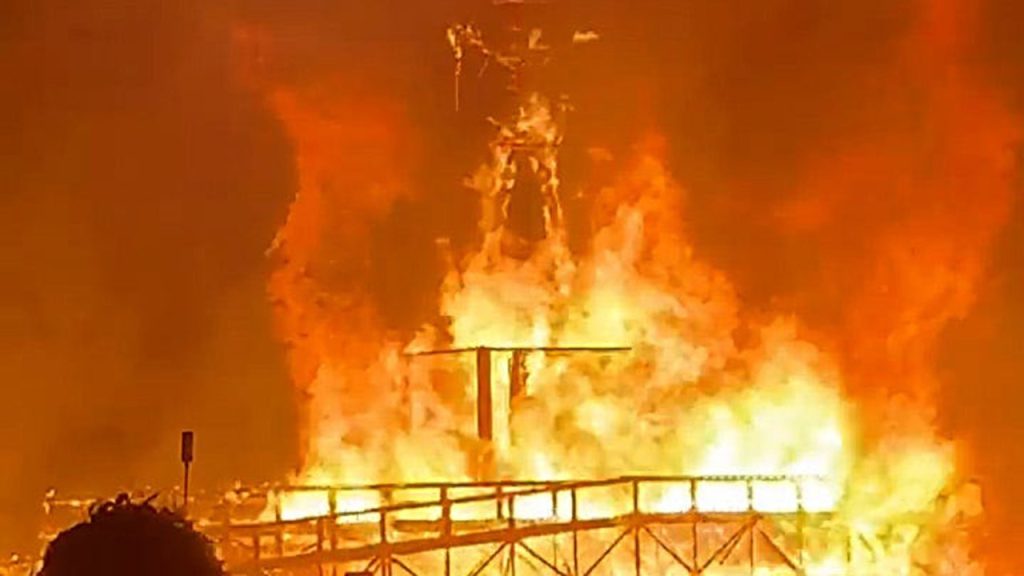The Many Faces of Burning Man 2024: Joy, Tragedy, and Unexpected Turns
This year’s Burning Man festival, the iconic annual gathering in Nevada’s Black Rock Desert, presented a stark tapestry of human experience that few could have anticipated. From August 24 to September 1, the temporary desert community witnessed extraordinary moments ranging from miraculous to tragic. While thousands gathered for the customary celebration of art, self-expression, and community, several unexpected incidents captured headlines and showcased both the resilience and vulnerability of the human condition in this unique desert environment. The most shocking incident was undoubtedly the homicide of 37-year-old Russian national Vadim Kruglov, who was found “lying in a pool of blood” in what authorities have described as an isolated incident. The Pershing County Sheriff’s Office continues its investigation without naming suspects, leaving festival-goers and the wider community seeking answers. This tragedy stands in stark contrast to the festival’s ideals of connection and community, and has cast a shadow over what many participants describe as a transformative experience.
In a remarkable turn of events that demonstrates life’s unpredictability, 37-year-old Kayla Thompson from Utah experienced what medical professionals call a cryptic pregnancy—giving birth to a daughter she didn’t know she was carrying. Thompson woke in her recreational vehicle on August 27 with what she initially mistook for abdominal cramps, only to realize she was in labor. The Burning Man community responded with immediate care and compassion, with nearby participants rushing to help, including an OB-GYN who arrived so quickly he was still in his underwear. The baby girl, named Aurora, weighed just 3 pounds and 9.7 ounces. Thompson’s sister-in-law, Lacey Paxman, noted how beautifully the community came together, regardless of appearance or convention, to help welcome this unexpected new life to the world. This extraordinary birth story highlights the profound human connections that can form in the festival’s unique environment.
The challenges of operating in a remote desert environment became evident through several medical emergencies requiring air evacuation. James “JP” Patrick was meditating on the desert floor during the festival’s final night when he was reportedly struck by a Tesla Cybertruck. The severity of his injuries necessitated an airlift for emergency surgery, with his wife Jade now facing a potential $50,000 medical bill for the helicopter transport alone. In a separate incident, another attendee was airlifted after possibly being electrocuted when stepping into a puddle of water, requiring additional treatment from external medical providers. These incidents underscore the inherent risks of creating a temporary city in such an isolated and harsh environment, where access to comprehensive medical care requires extraordinary measures and comes at significant financial cost.
The juxtaposition of these incidents against the backdrop of Burning Man’s philosophical underpinnings creates a complex portrait of the event. The festival, which transforms the barren desert into a vibrant temporary metropolis complete with themed camps and massive art installations, is built on principles of radical self-reliance and communal effort. When emergencies arise, these values are put to the test in real and sometimes life-altering ways. The community’s response to the unexpected birth—with strangers immediately stepping in to provide medical expertise and support—exemplifies the best of these principles. Conversely, incidents like the alleged homicide and vehicular accidents reveal the challenges of maintaining safety and order in such an unusual setting, where traditional social structures are intentionally reimagined.
Security concerns have become increasingly prominent at the festival over recent years. According to local reports, last year’s event saw 28 arrests by the Pershing County Sheriff’s Office, more than double the 13 arrests reported in 2023. This upward trend raises questions about how the festival can maintain its ethos of freedom and self-expression while ensuring participant safety. The homicide investigation particularly challenges the organization’s ability to balance openness with necessary security measures. Festival organizers have remained silent on these incidents so far, leaving attendees and observers to speculate on potential changes to future events. The evolution of Burning Man from its counterculture roots to a globally recognized event attracting tens of thousands has inevitably brought increased scrutiny and expectations regarding participant welfare.
Despite these troubling incidents, many participants continue to find profound meaning in the Burning Man experience. The festival remains a unique social experiment where people from diverse backgrounds come together to create art, build community, and explore alternative ways of being. The culminating ritual of burning the large wooden effigy—the event’s namesake—represents transformation and renewal, themes that take on added resonance in light of this year’s events. For the Thompson family, Burning Man will forever be associated with the miraculous beginning of their daughter’s life. For others, including those touched by tragedy or accident, the festival represents a more complicated memory. These contrasting experiences reflect the full spectrum of human life—birth and death, joy and sorrow, connection and loss—concentrated into one extraordinary week in the desert. As Burning Man continues to evolve, these incidents will likely inform discussions about how this temporary community can better protect its members while preserving the spontaneity and freedom that make it unique.











